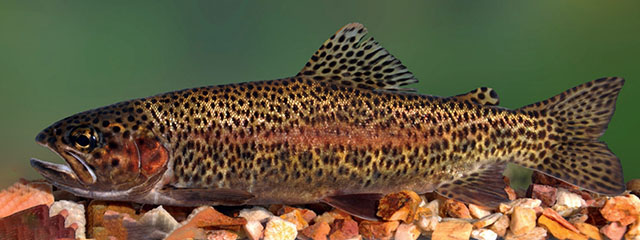|
Oncorhynchus mykiss (Walbaum, 1792) Rainbow trout |

|
|
photo by
Ramani Shirantha |
| Family: | Salmonidae (Salmonids), subfamily: Salmoninae | |||
| Max. size: | 122 cm TL (male/unsexed); max.weight: 25 kg; max. reported age: 11 years | |||
| Environment: | benthopelagic; freshwater; brackish; marine; depth range 0 - 200 m, anadromous | |||
| Distribution: | Pacific Slope from Kuskokwim River drainage in Alaska to Otay River drainage in California, USA. Widely introduced and established in Canada and USA, including Arctic, Atlantic, Great Lakes, Mississippi River, and Rio Grande basins, and elsewhere in the world (Ref. 86798). Eastern Pacific: Kamchatkan Peninsula and have been recorded from the Commander Islands east of Kamchatka and sporadically in the Sea of Okhotsk as far south as the mouth of the Amur River along the mainland. The records outside Kamchatka probably represent migrating or straying Kamchatkan steelhead (penshinensis) rather than the established native population (Reg. 50080). Several countries report adverse ecological impact after introduction. | |||
| Diagnosis: |
Dorsal spines (total): 0-0; Dorsal soft rays (total): 14-16; Anal spines: 0-0; Anal soft rays: 6-12; Vertebrae: 60-66. Diagnosis: Body elongate, somewhat compressed especially in larger fish. No nuptial tubercles but minor changes to head, mouth and color occur especially in spawning males. Colouration varies with habitat, size, and sexual condition; stream residents and spawners darker, colours more intense; lake residents lighter, brighter, and more silvery. Caudal fin with 19 rays (Ref. 2196). Differs from Oncorhynchus gorbuscha by having the following unique characters: anal fin with 6-9½ (usually 8½ ) branched rays; 115-130 scales in midlateral row; 16-17 gill rakers; breeding males lacking hump; juveniles lacking parr marks; wide pink to red stripe from head to caudal base, except in sea-run form; and juveniles with 5-10 parr marks (Ref. 59043). Description: Streamlined body with very small scales (Ref. 52193). Head rounded; mouth terminal, extending to hind margin of orbit when closed; jaws with sharp teeth, lower jaws of mature males slightly enlarged and hooked (Ref. 52193). Dorsal fin with 4 unbranched and 10-12 branched rays; anal fin with 3 unbranched and 6-12 branched rays; dorsal fin in midbody; small lobate adipose fin; caudal fin shallowly forked (Ref. 52193, 59043). Colouration: Colouration distinctive, body silvery or light golden with small black spots; dorsal and caudal fins black spotted; adipose fin with black edge and spotes; a broad lilac-mauve iridescent band from head to caudal fin (Ref. 52193). Older males tend to darken; juveniles have about 10 broad dark grey vertical bars along the body (Ref. 52193). |
|||
| Biology: | Inhabit clear, cold headwaters, creeks, small to large rivers, lakes, and intertidal areas (Ref. 86798). Anadromous in coastal streams (Ref. 5723). Stocked in almost all water bodies as lakes, rivers and streams, usually not stocked in water reaching summer temperatures above 25°C or ponds with very low oxygen concentrations. Feed on a variety of aquatic and terrestrial invertebrates and small fishes. At the sea, they prey on fish and cephalopods. Mature individuals undertake short spawning migrations. Anadromous and lake forms may migrate long distances to spawning streams (Ref. 59043). Utilized fresh, smoked, canned, and frozen; eaten steamed, fried, broiled, boiled, microwaved and baked (Ref. 9988). Cultured in many countries and is often hatched and stocked into rivers and lakes especially to attract recreational fishers (Ref. 9988). | |||
| IUCN Red List Status: | Least Concern (LC); Date assessed: 28 July 2020 (Least Concern) Ref. (130435) | |||
| Threat to humans: | potential pest | |||